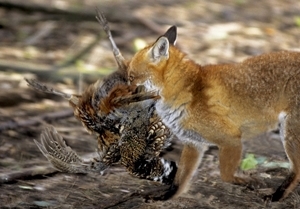- We believe that effective predator control must be rational, achievable, proportionate, focused and humane.
- Our research suggests that predation can be a common limiting factor for breeding success for many species in the UK, especially where there is limited habitat extent, quality and connectivity.
- Our research has described how effective predator control can raise species’ local abundance to levels higher than in the absence of predator control, resulting in improved conservation status given suitable habitat.
- We recognise there are legacy concerns over predator control and have improved the focus and humaneness of predator control techniques so that they do not threaten the predators’ conservation status.
- We do not advocate a return to the levels of predator removal that were prevalent around the turn of the 19th Century, but we do support evidence-led policies that back licensed predator management.
Conservation management has available many approaches for producing and maintaining resilient wildlife and habitats. We believe that whichever tool or tools are used, they should be effective and chosen on a rational basis taking into account practicality of use, proportionality of response to the predation threat, specificity and humaneness.
Impacts and solutions
 Since the early 1980s, the GWCT has published over 150 papers considering predation effects. These increasingly clearly show that predation pressure can in some places depress numbers of game and wildlife, particularly of ground-dwelling species1,2. The reduction in abundance is caused by losses of adults, eggs or young. High predation pressure can halt sustainable driven wild game shooting3, and reviews of many research papers indicate that it can prevent the recovery of declining species of wildlife4.
Since the early 1980s, the GWCT has published over 150 papers considering predation effects. These increasingly clearly show that predation pressure can in some places depress numbers of game and wildlife, particularly of ground-dwelling species1,2. The reduction in abundance is caused by losses of adults, eggs or young. High predation pressure can halt sustainable driven wild game shooting3, and reviews of many research papers indicate that it can prevent the recovery of declining species of wildlife4.
The implications for conservation and investment in sporting management are clear. In the uplands, black grouse and capercaillie ranges would contract further if predation pressure increased5,6. Birds such as curlew and lapwing are typically now restricted to upland areas where predators are controlled to benefit red grouse7. In the lowlands, predator pressure has been shown to limit grey partridge recovery, corvid predation to impact on thrushes, and fox predation to restrict the abundance of brown hares8,9,10.
Our and others’ research has shown not only that predation causes these impacts, but that predator control can reduce them to the point where effective conservation is achieved11. The impact of predators is now generally recognised by a wide range of bodies at both policy and practical levels12. As a result predator control is used not just by farmers and gamekeepers, but on a wide range of designated sites and nature reserves around the country and in some places it is supported by public-sector finance13.
Predator and habitat management
But predator control alone is not sufficient to address conservation challenges. The demand for food, fuel and fibre from a small, finite land area has led to declining extent, quality and connectivity of existing wildlife habitats. This in turn has often led to poor population connectivity and thus low population resilience. Having suitable habitats in adequate amounts for reproduction and survival is crucial for all species. However, habitat management is not always enough on its own to improve conservation14.
Good-quality habitats, supported by farm and sporting management, are essential if predator control is to be justified. Assuming that habitat quality has been addressed, that predation pressure is high, and that the management tools chosen are effective in removing enough predators, we believe predator control can be a cost-effective management action to improve survival and recruitment. It is also likely to stimulate interest in wider landscape conservation from land managers who see cultural and economic value in game and wildlife15.
Predator conservation
 The benefits of such an approach are not just for game, waders and songbirds. Reducing numbers of some of the common generalist predators can benefit some rare predators. Pine martens may suffer from fox predation16. Ground-nesting harriers do well on virtually fox-free islands, e.g. the Orkney Islands, Islay, Arran and the Isle of Man and have been found to decline on a grouse moor when fox control stops17.
The benefits of such an approach are not just for game, waders and songbirds. Reducing numbers of some of the common generalist predators can benefit some rare predators. Pine martens may suffer from fox predation16. Ground-nesting harriers do well on virtually fox-free islands, e.g. the Orkney Islands, Islay, Arran and the Isle of Man and have been found to decline on a grouse moor when fox control stops17.
However, being demonstrably beneficial in many situations is not a carte blanche for control; predator control must also be sensitive to the predators being taken. Many predators in the UK are recovering in numbers while some are at an all-time high18. But there is little doubt that the 19th Century drive to increase game abundance led to intense predator control that was responsible for the disappearance of many raptors and small carnivores from large parts of Britain19,20. This legacy brought predator control, often wrongly described as ‘keepering’, into disrepute driving a perception of incompatibility with conservation.
Predator control is justifiable only if it removes enough predators to be effective, but we emphatically do not advocate a return to the levels of predator removal that were prevalent around the turn of the 19th Century. Our objective in conservation must be to reduce predation pressure on wildlife using the most satisfactorily humane methods available while at the same time maintaining the community of predators in the country as whole. Our research into the trapping of crows and snaring of foxes has improved the specificity of predator control and the welfare of trapped predators21,22.
We support laws and the operation of laws through licences which allow the control of predators that cause significant damage, provided that the nature of the control does not jeopardise the national conservation status or welfare of the predators themselves. We believe that, for some common predators, these licences need place few restrictions on the intensity or timing of control as the effect on a predator’s numbers is short-term and local, and provided welfare is not significantly compromised.
Conflict resolution
Where vulnerable and nationally important predators overlap with areas where there is a game interest, sometimes because of the prey-base that is supported, conflict may arise if the predators have an adverse effect on game stocks. In such cases we need an adaptive approach whereby agreements are reached between landowners and government, allowing sustainable numbers of both predator and prey to be achieved. Grants, intra-guild effects, limited culls, target predator densities and other mechanisms should be used to serve the long-term interest of the predator as well as the game populations23.
There may be areas where a high game interest predominates, as is currently found, for example, on some upland areas, where contiguous properties are managed principally for grouse. In these regions some predators could be scarce as a result. We see nothing intrinsically wrong in this, provided it is offset by good numbers of the same predators in other regions, the conservation status of the predators is secure, and other important ecosystem services are being delivered in these areas as a consequence.
Adam Smith
Director Scotland
July 2014
Based on Tapper, S. (1999) A Question of Balance
Images © David Mason and Laurie Campbell
References
- Aebischer, N.J. (2009). Gamebird science, agricultural policy and biodiversity conservation in lowland areas of the UK. In: Dickson, B., Hutton, J. & Adams, W.M. (eds) Recreational Hunting, Conservation and Rural Livelihoods - Science and Practice: 197-211. Blackwell Publishing Ltd, Oxford.
- Sotherton, N.W., May, R., Ewald, J.A., Fletcher, K. & Newborn, D. (2009). Managing uplands for game and sporting interests. An industry perspective. In: Bonn, A., Allott, T., Hubacek, K. & Stewart, J. (eds) Drivers of Environmental Change in Uplands: 241-260. Routledge, Abingdon.
- Redpath, S.M. & Thirgood, S.J. (1997). Birds of Prey and Red Grouse, London Stationery Office.
- Smith, R. K., A. S. Pullin, G. B. Stewart, & W. J. Sutherland. (2010). Effectiveness of predator removal for enhancing bird populations. Conservation Biology, 24: 820-829.
- Warren, P.K. & Baines, D. (2002). Dispersal, survival and causes of mortality in black grouse Tetrao tetrix in northern England. Wildlife Biology, 8: 91-97.
- Summers, R.W., Green, R.E., Proctor, R., Dugan, D., Lambie, D., Moncrieff, R., Moss, R. & Baines, D. (2004). An experimental study of the effects of predation on the breeding productivity of capercaillie and black grouse. Journal of Applied Ecology, 41: 513-525.
- Tapper, S.C. (2010). Waders on the Fringe. Why Nationally Scarce Waders Flourish on Grouse Moors. Game & Wildlife Conservation Trust, Fordingbridge, Hampshire.
- Tapper, S.C., Potts, G.R. & Brockless, M.H. (1996). The effect of an experimental reduction in predation pressure on the breeding success and population density of grey partridges Perdix perdix. Journal of Applied Ecology, 33: 965-978.
- White, P.J.C., Stoate, C., Szczur, J. & Norris, K.J. (2014). Predator reduction with habitat management can improve songbird nest success. Journal of Wildlife Management, 78: 402-412.
- Reynolds, J.C., Stoate, C., Brockless, M.H., Aebischer, N.J. & Tapper, S.C. (2010). The consequences of predator control for brown hares (Lepus europaeus) on UK farmland. European Journal of Wildlife Research, 56: 541-549.
- Fletcher, K.L., Aebischer, N.J., Baines, D., Foster, R. & Hoodless, A.N. (2010). Changes in breeding success and abundance of ground-nesting moorland birds in relation to the experimental deployment of legal predator control. Journal of Applied Ecology, 47: 263-272.
- Smith, R.K., Pullin, A.S., Stewart, G.B. and Sutherland, W.J. (2010), Effectiveness of Predator Removal for Enhancing Bird Populations. Conservation Biology, 24: 820–829.
- Sotherton, N.W. & Reynolds, J.C. (2011). Managing the UK's wildlife: Must we intervene to regulate numbers? Journal of the Royal Agricultural Society of England, 172: 1-9.
- Gibbons D.W., Amar A., Anderson G.Q.A., Bolton M., Bradbury R.B., Eaton M.A., Evans A.D., Grant M.C., Gregory R.D., Hilton G.M., Hirons G.J.M., Hughes J., Johnstone I., Newbery P., Peach W.J., Ratcliffe N., Smith K.W., Summers R.W., Walton P. and Wilson J.D. (2007). The predation of wild birds in the UK: a review of its conservation impact and management. RSPB Research Report no 23. RSPB, Sandy.
- Sotherton, N.W., Tapper, S.C. & Smith, A.A. (2009). Hen harriers and red grouse: economic aspects of red grouse shooting and the implications for moorland conservation. Journal of Applied Ecology, 46: 955-960.
- Strachan, R., Jeffries, D.J. & Chanin, P.R.F. (1996). Pine Marten survey of England and Wales. 1987-1988. JNCC, Peterborough.
- Baines, D. & Richardson, M. (2013). Hen harriers on a Scottish grouse moor: multiple factors predict breeding density and productivity. Journal of Applied Ecology, 50: 1397-1405.
- Bird Atlas 2007–11: The Breeding and Wintering Birds of Britain and Ireland (D.E. Balmer, S. Gillings, B.J. Caffrey, R.L. Swann, I.S. Downie, and R.J. Fuller, Editors). BTO Books, Thetford, UK.
- Newton, I. (1979) Population Ecology of Raptors. T. & A. D. Poyser, Berkhamsted, Hertfordshire.
- Langley, P.J.W & Yalden, D.W. (1977) The decline of the rarer carnivores in Great Britain during the nineteenth century. Mammal Review, 7: 95-116.
- Reynolds, J.C. (2004). Trade-offs between welfare, conservation, utility and economics in wildlife management - a review of conflicts, compromises and regulation. Animal Welfare, 13: S133-138.
- Short, M.J., Weldon, A.W., Richardson, S.M. & Reynolds, J.C. (2012). Selectivity and injury risk in an improved neck snare for live-capture of foxes. Wildlife Society Bulletin, 36: 208-219.
- Redpath, S.M., Amar, A., Smith, A.A., Thompson, D.B.A. & Thirgood, S.J. (2010). People and nature in conflict: can we reconcile hen harrier conservation and game management? In: Baxter, J.M. & Galbraith, C.A. (eds) Species Management: Challenges and Solutions for the 21st Century: 335-350. TSO (The Stationery Office).